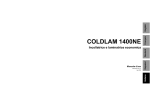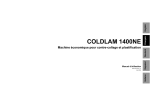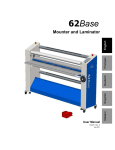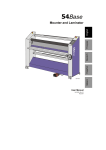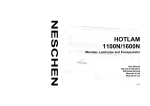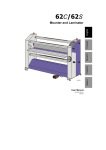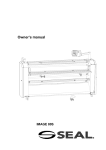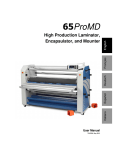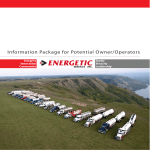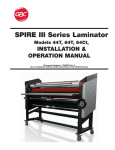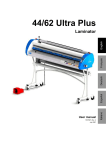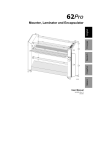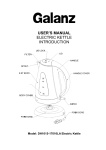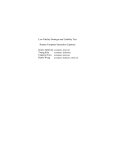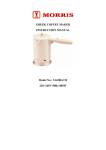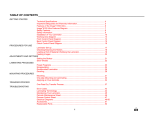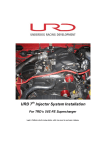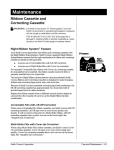Download Cold Lam 1400-N
Transcript
UM121EN, Rev.1.0 Français English User Manual Deutsch Economy Mounter and Laminator Español COLDLAM 1400NE Italiano Aug.2004 TABLE OF CONTENTS TABLE OF CONTENTS ...............................................................2 INTRODUCTION ..........................................................................3 THIS MANUAL .............................................................................3 1 WARRANTY AND SAFETY INSTRUCTIONS ........................4 1.1 Warranty .............................................................................4 1.2 1.3 1.1.1 1.1.2 Warranty conditions ........................................................4 Warranty period...............................................................4 Safety ..................................................................................5 1.2.1 1.2.2 Safety features ................................................................5 Safety instructions ...........................................................5 1.3.1 1.3.2 1.3.3 General ESD-warning .....................................................6 In this manual ..................................................................6 On the machine ...............................................................6 4 OPERATING ..........................................................................12 4.1 Process controls..............................................................12 4.2 4.3 4.4 Warnings ............................................................................6 4.5 2 DESCRIPTION .........................................................................7 2.1 General description ...........................................................7 2.2 2.1.1 Parts recognition .............................................................7 2.2.1 2.2.2 2.2.3 2.2.4 2.2.5 2.2.6 Identification ....................................................................8 Machine dimensions .......................................................8 Working area ...................................................................8 Machine specifications ....................................................9 Material specifications.....................................................9 Delivered with the machine.............................................9 Specifications ....................................................................8 2.3 Process principle...............................................................9 3 INSTALLATION .....................................................................10 3.1 Unpacking ........................................................................10 3.2 Installation........................................................................11 3.3 Transport ..........................................................................11 2 4.1.1 4.1.2 Control panel .................................................................12 Additional controls.........................................................13 4.2.1 4.2.2 Normal mode.................................................................14 Slow mode.....................................................................14 4.3.1 4.3.2 Auto-grip shafts .............................................................15 Loading shaft with film rolls...........................................16 4.4.1 4.4.2 4.4.3 4.4.4 4.4.5 Release liner and splitter bars ......................................17 Using the upper section only ........................................17 Upper and lower section ...............................................18 Presetting the tension ...................................................19 Pressure setting ............................................................19 4.5.1 4.5.2 4.5.3 4.5.4 4.5.5 4.5.6 Mounting images or decals...........................................20 Pre-coating panels ........................................................21 Over-lamination .............................................................21 Single-sided lamination.................................................21 Double-sided lamination ...............................................22 Decaling.........................................................................22 5.1.1 Cleaning the silicone covered rollers............................23 5.2.1 Auto-grip shafts .............................................................24 Operating modes .............................................................14 Placing film rolls ..............................................................15 Webbing............................................................................17 Processes and settings...................................................20 4.6 Unloading .........................................................................22 5 MAINTENANCE .....................................................................23 5.1 Cleaning............................................................................23 5.2 Preventive maintenance..................................................24 5.3 Trouble shooting .............................................................24 5.4 Technical assistance.......................................................25 6 GLOSSARY ...........................................................................26 Table of contents THIS MANUAL Thank you for purchasing your ColdLam 1400NE. This manual is intended for users of the ColdLam 1400NE. Read this manual carefully before starting the machine. This manual contains important information for correct installation, operation and maintenance of the machine. It also contains important instructions to prevent accidents, personal injury or serious damage prior to or during operation of the machine. Familiarize yourself thoroughly with the functioning and operation of this machine and strictly observe the directions given. If you have any questions or need further details on specific aspects related to this machine, please do not hesitate to contact us. The address and phone number is stated on the copyright page. Chapter 1 will provide the safety and warranty information. Read this chapter carefully. Chapter 2 provides a general description of the machine and its specifications. Chapter 3 guides you through the installation of the machine. This chapter also provides information for moving, transport and decommissioning of the machine. Chapter 4 guides you through the operation in various processes to develop basic knowledge of the machine. Chapter 5 provides maintenance procedures for long time efficient and trouble free operation of the machine. Maximum effort has been invested in the design of this machine to give you years of reliable service. As you become familiar with your machine you will appreciate the high quality of its output and the excellence in engineering stated in its smartly styled design. The machine described in this manual is a multi-functional machine that can perform the following processes; • high-quality lamination, • panel mounting of images, • decaling, The process results can be controlled by: • speed setting, • pressure setting, • unwind tension of the film(s). Introduction 3 English INTRODUCTION The warranty period and conditions stated in this chapter is merely a summary of the general warranty conditions. For the exact details on the warranty period and conditions for your machine, please contact your dealer. Warranty is voided when: • Changes or modifications are made to this machine, not explicitly approved by the manufacturer. • The machine is changed or modified by unauthorized persons. • The machine is used under other than normal working conditions. • The machine is used for purposes other than intended for (see page 3). * The original end user is the person that first purchased the machine from the manufacturer or its representative. 1.1.1 1.1.2 1 WARRANTY AND SAFETY INSTRUCTIONS 1.1 Warranty Warranty conditions The manufacturer warrants to the original end user* that the machine when proven defective in materials or workmanship, within the applicable warranty period will be repaired, or (at our option) replaced without charge. Note: The main rollers are subject to normal wear and tear and therefore have warranty on material defects only. The manufacturer or its representative shall not be liable for any damage caused by the machine nor loss of productivity. 4 Warranty period The standard warranty period on this machine is one year from the date of purchase. The warranty period however can be longer by local law or by purchase agreement. The main rollers have a warranty period of half a year on material defects only. The warranty ends when: • The periods stated above have expired. • The machine changes possession. • Warranty is voided by any of the conditions mentioned above. Warranty and Safety instructions This machine is provided with safety equipment to promote safe machine operation. The manufacturer has done everything possible to prevent any possible danger and to inform you as accurately and comprehensively as possible of any hazards relating to the operation of the machine. You should nevertheless proceed with caution when operating the machine. Read the safety instructions below and familiarize yourself with the warning symbols summarized in the Warnings section. 1.2.1 Safety features Emergency stops The machine has 2 Emergency stops. When activated, the machine will come to a complete stop and the power to the motor controller is switched off. The Emergency stops must be disengaged before a restart is possible. Optical safety devices The machine has an optical safety device at the input side of the opening (nip) between the main rollers. This device performs a check of the operation between transmitter and receiver. When an error is detected (e.g. the signal is interrupted) the motor will stop and the motor controller will be disabled. The stop signal from the optical device is overruled when: • The machine is running in reverse direction, • The slow mode has been activated and the footswitch is pressed. Safety footswitch The safety footswitch is used as remote control to start and stop the machine in the normal and the slow mode. WARNING: THE OPTICAL SAFETY DEVICE IS DISENGAGED WHEN USING THE SAFETY FOOTSWITCH IN SLOW MODE. SO, KEEP CLEAR OF THE NIP WHEN PRESSING THE FOOTSWITCH, WHILE SLOW MODE IS ACTIVE. The safety footswitch is protected with a safety lock to prevent accidental switching. Insert the forefoot completely to disengage this lock. Slow mode The slow mode is used when setting up the machine with new films or images. In slow mode the machine is started with the footswitch and will then run at a fixed low speed so that the operator has both hands free to position and feed new film or image correctly into the machine. 1.2.2 Safety instructions Work safely! The owner of the machine is responsible for safe operation of the machine. He therefore is obliged to familiarize operating personnel with the contents of this manual and make them aware of all possible hazards. Do not change, remove or disable the safety facilities! Warranty and Safety instructions 5 English 1.2 Safety 1.3 Warnings 1.3.1 General ESD-warning WARNING: DANGER OF ELECTRIC SHOCK BY ELECTROSTATIC DISCHARGE. PROCESSING FILMS THROUGH LAMINATING ROLLERS WILL CAUSE BUILD-UP OF ELECTROSTATIC CHARGES. An anti-static floor coating and wearing anti-static clothing and footwear can reduce the risk of ESD-shock. 1.3.2 In this manual In this manual you will find 3 levels of warnings. WARNING: THE WARNING MESSAGE IS USED WHEN A LIFETHREATENING SITUATION MAY ARISE OR PERSONAL INJURY CAN OCCUR. FOLLOW THE INSTRUCTIONS CLOSELY. 1.3.3 On the machine On the machine you will find the following warning symbols. ROTATING PARTS (1) DANGER OF GETTING INJURED BY ROTATING PARTS. MAKE SURE THAT THESE ROTATING PARTS DO NOT CATCH YOUR FINGERS, CLOTHING, HAIR, ETC. This symbol is placed on the inside side panel on both sides of the machine, just above the upper main roller, visible from the front and rear side. ESD SHOCK (2) DANGER OF GETTING AN ELECTRIC SHOCK CAUSED BY ELECTROSTATIC CHARGE BUILDUP IN THIS AREA. This ESD symbol is placed in those places most likely to build-up electrostatic charges. CAUTION: The caution message is used when there is danger of damage to the machine or materials. Follow the instructions to prevent damage. Note: This message is used to give you useful information for easier operation, to prevent waste of material, etc.. Figure 1: Warning symbol positions. 6 Warranty and Safety instructions 2 DESCRIPTION 2.1.1 This chapter describes the machine and its operating basics. In this machine the following parts can be recognized: English Parts recognition 2.1 General description The machines described in this manual is a mono-directional machine dedicated for processing pressure sensitive materials. While feeding through images and the coating films, the two silicone-coated main rollers generate the pressure. The area where the upper and lower main roller meet is called the “nip”. The upper main roller can be moved up or down, so the nip can be varied to feed materials of various thicknesses. The nip setting handwheel also sets the pressure for the laminating process. The lower main roller is motor driven. The speed can be manually set between zero and a given maximum value. The machine has two material unwind shaft positions in the rear. The supports in the upper front position can clamp a (plastic) cilinder used for release liner wind-up. The machine can be divided into an upper and a lower section. The upper section, above the in-feed table, is suitable for unwind material with release liner. The lower section can only unwind material without release liner. Description Figure 2: Main parts identification. 1. 2. 3. 4. Leveling feet 5. 6. 7. 8. Table switch Foot switch Splitting bar Nip setting and pressure control wheel In-feed table Image guide 9. Release liner wind-up shaft 10. Emergency button 11. Unwind shaft 12. Main rollers 13. Output table 14. Identification label 15. Main power entry 16. Castors Control panel 7 2.2 Specifications 2.2.1 Identification The machine identification label is located at the bottom of the righthand cabinet, on the rear side of the machine. This label indicates the model and the power supply requirements. CAUTION: The mains supply must match the values indicated on the machine identification label. An example is shown below. 2.2.2 Machine dimensions Uncrated: Width Height Depth Working height Weight Crated Width Height Depth Weight 2.2.3 8 cm cm cm cm kg 200 162 90 330 cm cm cm kg Working area Width Depth Figure 3: Machine identification label. 190.5 128 62.1 90 288 310 cm 190 cm + 2x maximum board length Note: Anti-static clothing and footwear of the operator and an anti-static floor coating will help reduce the build-up of electrostatic charges (ESD). A relative humidity of at least 70% also helps reducing ESDbuild-up. Description 2.3 Process principle Machine specifications Power supply: 1N/PE 230VAC +/- 10%, 50/60Hz, 2A For the correct supply voltage version refer to the identification label on the machine. Standard number of shafts Material unwind 2 (auto-grip) Release liner wind-up 1 Nip setting 0–52 mm Pressure 0.3–0.8 N/mm Process speed Maximum 5 m/min Slow mode 0.6 m/min Reverse 0.6 m/min Noise level <70 dB(A) 2.2.5 Material specifications Maximum width Maximum roll diameter Material unwind Release liner wind-up Maximum panel thickness Roll core inside diameter 2.2.6 In all processes the materials are fed through the nip from the front side to be joined together by pressure. A process that makes maximum use of the machine is shown in Figure 4. Shown is a double sided laminating (decalling) process. The top coating film is a pressure sensitive film with release liner (3) taken from a supply roll on the (rear) upper unwind shaft (5). The bottom coating film is a pressure sensitive (mounting) film without release liner taken from a supply roll on the lower unwind shaft (8). 1400 200 150 50 76.2 Delivered with the machine 2 Ramps (to roll off the machine from the transport pallet). 1 Single head open-end wrench (to adjust leveling feet). 1 User manual. Description mm Figure 4: Creating Pop-up art. mm mm mm mm The image that has to be coated on both sides is fed between the main rollers (1) via the in-feed table (2). When using a pressure sensitive laminate, it often has a release liner (3) that has to be removed. As in the top half, it runs via a splitter bar (6) where the release liner is removed. This release liner is rolled up onto the wind-up shaft (4) in the upper section. When using a pressure sensitive laminate without a release liner (like in the bottom section), it must not run via the splitter bar to avoid the film sticking to the bar and leaving adhesive residue behind. A mounting film has adhesive on both sides and release liner on just one side. This release liner has to stay on until the image is mounted. So a mounting film is processed in the bottom section the same way as a laminate without release liner. 9 English 2.2.4 3 INSTALLATION WARNING: INSTALLATION MUST BE CARRIED OUT BY SKILLED PERSONNEL. 3.1 Unpacking At delivery, the machine is transported in a carton box and is fastened onto a wooden pallet. Place the pallet in a space where there is enough room to roll off the machine from the pallet (approx. 3x the length). To unpack, follow the steps below (refer to Figure 5); 1. 2. 3. 4. 5. Cut the straps and lift off the carton box. Remove the four securing bolts (1). Turn down the four leveling feet (2) to lift the machine. Remove the wooden blocks (3). Unscrew and remove the two ramps. Place the two ramps (4) against the roll-off side of the pallet so that the castors (5) will run clear from the edge. 6. Turn up the four leveling feet (2) to put the machine on its castors (5). 7. Roll the machine off carefully from the pallet using the ramps. WARNING: ROLL THE MACHINE OFF WITH 2 PERSONS. IT IS HEAVY AND CAN NOT BE CONTROLLED ALONE. Note: Save all packing material for future moving over large distance or discard of according to local regulations. Figure 5: Removing transport parts. 10 Installation 1. Move the machine to its final place. Note: Make sure that the machine, in its final position, has adequate space. You will need room to feed, receive and trim images. L = Maximum board length S = Minimum space 60 cm English 3.2 Installation CAUTION: Check the mains values before connecting. See section 2.2.4 for power supply details. Only if absolutely necessary, use an extension cable of ample capacity. Unroll the extension cable completely. 6. Connect the machine to the mains using the power cable supplied with the machine. WARNING: MAKE SURE THE POWER SUPPLY CABLE AND/OR THE EXTENSION CABLE IS NOT BLOCKING YOUR WAY AROUND THE MACHINE. Figure 6: Working space. 3.3 Transport 2. Turn down the four leveling feet until the castors are free from The machine can be transported on a smooth surface on its castors. the floor. 3. Level the machine by adjusting the four leveling feet. Put the spirit level horizontal on the upper main roller and vertical against the front of both cabinets. CAUTION: Turn the leveling feet up completely to prevent them from bending or breaking if accidentally bumping into an obstacle. 4. Remove all transport material. • • Cut the straps and move up the top main roller to remove the wooden blocks and the transport foam from the nip. Cut the straps around the shaft suspensions and remove the transport foam. When moving the machine on rough surfaces or over long distances, use the original pallet and packing material and and move it with a pallet truck or forklift. 5. Unpack the in-feed table and install it with its rollers in the rails. Installation 11 4 OPERATING This chapter describes the function of the controls and indicators, the operating modes, how to set up and operate the machine and a number of applications. 4.1 Process controls This section gives an overview of the controls on the control panel (Figure 7) and elsewhere on the machine (Figure 8). 4.1.1 Control panel This paragraph describes the controls and indicators on the control panel. Control ON/OFF (1), toggle pushbutton; Press 1 second to switch the machine from stand by to active or back. WARNING: WHEN THE POWER CORD OF THE MACHINE IS PLUGGED IN, THE MACHINE IS CONSTANTLY POWERED. Power indicator (2), LED; The LED will light when the machine is powered. The LED flashes when the machine is in stand-by mode. Safety indicator (3), LED; The LED will light when the beam of the optical safety device at the input side of the nip is not interrupted. Forward (4), pushbutton and LED; Press to start the rotation of the rollers in the forward direction. The LED will light when the forward mode is selected. Reverse (5), pushbutton and LED; Press and hold for rotation of the rollers in reverse direction. The LED will light and an audible signal is heard when the rollers are rotating in the reverse direction (reverse mode). Forward and reverse indicator flashing; When both LEDs are flashes, it indicates a motor overload. Press the stop button and check the material flow and the tension setting of the unwind shafts. If the error persists, contact your service organization. Figure 7: Control panel 12 Stop (6), pushbutton; Press to stop the rotation of the rolls. Operating English Speed control (7), control knob; Sets the speed anywhere in a range between 0 and 10 (See specifications for actual speed range). Slow mode (8), toggle pushbutton and LED; Press 1 second to switch slow mode ON or OFF. To run at the fixed slow mode speed the footswitch must be pressed. The LED will light when slow mode is selected. CAUTION: When slow mode is active the machine can still run at high speed. Slow mode indication is NOT a speed indication. It is a working method. 4.1.2 Additional controls This paragraph describes all controls outside the control panel. Emergency stop buttons (1), push and hold button; When pressed the rotation of the rolls is stopped immediately and the button is locked into this stop position. Turn the button to unlock it. Pressing start, reverse or footswitch starts the process again. Nip setting wheel (2), geared wheel; Turn the wheel clockwise to narrow (close) the nip or counterclockwise to widen (open) the nip. When both rollers touch the materials, the pressure is set as follows.By turning the wheel clockwise the pressure is increased. Turning the wheel counter-clockwise the pressure will decrease. The nip setting and the pressure are indicated on the control panel. Operating Figure 8: Additional controls Foot switch (3), snap switch; Press and hold the switch to start the rotation of the rolls. Insert the forefoot completely to disable the safety lock that prevents accidental starting. When the switch is released, the rotation of the rolls will stop. Unwind tension control (4), ring; By turning this ring counter-clockwise (top to rear) an amount of friction is set between the shaft and the frame, so this will act as a brake. Tightening the brake will apply more tension to the material on the shaft. Turning the ring clockwise (top to front) will release the brake and therefore release the tension. 13 4.2 Operating modes The machine is either in normal mode or slow mode. In both modes the rollers can rotate in forward direction and in normal mode the rollers can also rotate in reverse direction. 4.2.1 Normal mode When slow mode is not selected, the rotation speed of the rollers is set by the speed control knob (normal speed). Reducing the processing speed in general results in a better laminating quality. Start rotation by pressing the forward button or the footswitch. Rotation stops when a stop button is pressed or the footswitch is released. Note: To return control from the footswitch to the control panel without stopping, press and hold the forward button, release the footswitch and then release the forward button. An interruption of the light beam of the optical safety device in front of the rollers will also stop the rotation of the rollers. To continue after the interruption is taken away, the process must be started again. Reverse Press and hold the reverse button to rotate the rollers in the reverse direction. The speed is fixed to the slow mode speed. WARNING: KEEP CLEAR OF THE REAR SIDE NIP WHEN RUNNING IN REVERSE MODE. The rear side has no finger protection. When running in reverse, the optical safety device at the front side nip is ignored. An audible signal is heard to warn you for posible danger. 14 4.2.2 Slow mode Enter or leave Slow mode by pressing the slow mode button for 1 second. The selection is indicated by the slow mode indication LED. Entering slow mode will not change anything to the current movement of the rollers. In slow mode the rollers can run at normal or at slow mode speed. Normal speed Press the forward button in slow mode to run at a normal speed determined by the speed control setting (see normal mode). Slow mode speed Press and hold the footswitch in slow mode to force the rollers to run forward at a fixed low speed (see specifications) independent from the speed control. WARNING: KEEP CLEAR OF THE NIP WHEN RUNNING AT SLOW MODE SPEED. When running at slow mode speed, the optical safety devices are ignored and an audible signal is heard to indicate danger. When the footswitch is released, the forward rotation is stopped. Note: To change from slow mode speed to normal speed without stopping, press and hold the start button, release the footswitch and then release the start button. Pressing the footswitch again will slow down rotation to slow mode speed again. Operating This section describes the loading of the machine with laminating or mounting films. The films are loaded onto the shafts at the rear side of the machine. Auto-grip shaft lock. English 4.3 Placing film rolls To prevent the auto-grip shaft from jumping out of its support, a locking plate is installed on the left hand support. To take out the auto-grip shaft: Note: Always work in the center of the machine. Select films that are slightly wider than the print width of the image. This way the print can be trimmed with a border, but waste is reduced. 4.3.1 Auto-grip shafts Both shafts in the rear of the machine are the same. The shafts fit into the machine in both ways. On the control panel side of the machine all the shafts and the supports snap together. A spring inside the left-hand side support pushes the shaft into locking position when the shaft is turned. To position the shaft correctly turn the shaft until it locks in. Check the auto-grip mechanism on each shaft. The rubber cords should just not touch the edges of the recess (d = 8 ± 2.5 mm) If not, see chapter 5 Maintenance. Figure 10: Auto-grip locking bracket. 1. Hold the locking plate (C) with your right hand at (A) in the upper position ((B) is above the shaft). 2. Push the shaft with your left hand, to the right against the spring and remove it from the support at your left-hand side. 3. Now with both hands take out the shaft. Figure 9: Auto-grip shaft When the shaft is rotated inside a cylinder, the rubber cord will move to the side and gets caught between shaft and cylinder (Figure 9B). Rotating back will release the cord. Operating 15 4.3.2 Loading shaft with film rolls The film roll is put on the shaft depending on the type of film and the use in the upper or lower section of the machine. In general pressure sensitive film with release liner (A) is rolled up with the liner (3) and adhesive (2) to the outside of the film (1), whereas film without release liner (C) has its adhesive layer to the inside of the roll. However North American pressure sensitive films in general have the release liner on the inside of the roll (B). Figure 11: Film rolls. • • In the upper section, the adhesive (2) side in contact with the image and the release liner (3) must be on the top when unwinding the film to the front of the machine. In the lower section, the adhesive (2) side in contact with the image must be on the bottom when unwinding the film to the front of the machine. 1. Take the auto-grip shafts from the unwind positions of the machine. 2. Slide the shafts into the film rolls. 3. Place the shafts back into their supports as described above. Unwind direction of film towards the front of the machine: in the upper section; • film with release liner on the outside unwinds from the top (A), • film with release liner on the inside unwinds from the bottom (B), • film without release liner unwinds from the bottom (C). in the lower section; • film without release liner unwinds from the top (D). 4. Turn the shaft until the grippers lock in. 5. Position the film and the scrap core in the middle and align them. Note: When both upper and lower section are used, place both films at exactly the same position. 6. Make sure the films are set up and aligned properly. Figure 12: Film adhesives. 16 Operating For laminating processes the machine must be webbed before images on thin film or on panels can be processed. The machine can be webbed for single sided or double sided processing. When mounting images the machine is not webbed. would leave adhesive remains behind on the splitter bar, so this is lead over the splitter bar In the lower section (C), the film is running underneath the splitter bar to avoid adhesive remains staying behind on it. 4.4.2 English 4.4 Webbing Using the upper section only Note: In single sided processes adhesive residues will stay behind on the bottom roller where the film is wider than the images. To prevent this, use film of the same width as the image. Or, a release liner of the same width as the top film can be used in the bottom section. The release liner can easily be removed later on. When processing panels, a leader panel (waste panel equal to the panels to process) is needed to feed in the film and set the pressure and tension. When processing thin images a release board is needed to feed in the film. When through, the release board is then cleaned and can be used again. 4.4.1 Release liner and splitter bars In the upper section, when processing film with release liner, the splitter bar is used to split release liner from the film. The release liner is wound-up on the tube in the front of the machine. Figure 14: Webbing upper section. 1. Remove the image guide. 2. Unwind the film from the upper or top unwind roll. • • Feed a film without release liner over the splitter bar (A). Feed a film with release liner underneath the splitter bar (B). 3. Pull the film forward until approximately 10 cm (4 in.) is on the in-feed table. If the film has a release liner: • Peel off the release liner. • Pull the release liner up and stick it to the tube on the windup position. 4. Stick the leader panel to the film and feed the panel into the nip using slow mode. Figure 13: Use of a splitter bar. The film with release liner (A) is running underneath the splitter bar, where the release liner is split off. Film without release liner (B) Operating Note: Use a carrier board when processing thin images. 17 4.4.3 Upper and lower section Figure 15: Upper and lower section webbed. The film in the upper section is webbed first 1. Feed the film underneath (B) the splitter bar (between splitter bar and upper roller) • Film without a release liner must be fed over the splitter bar (A). 2. Pull the film forward until it almost reaches the in-feed table and apply it to the upper roller. If the film has a release liner (B): • Peel off the release liner, • Pull it up and stick it from below onto the tube on the windup position. 18 Now web the lower section Figure 16: Webbing lower section. 3. Pull the in-feed table towards you (A). 4. Unwind the film from the lower unwind roll. 5. Pull the film forward underneath the splitter bar until the end reaches above the nip and stick it to the film from the upper section. 6. Push back the in-feed table (B). 7. Push the films with a leader panel (C) into the nip using slow mode. Note: Use a leader panel of the same material, thickness and width as the panels to process. Use a release board when processing thin images. Operating Presetting the tension Panels To enable the film to unwind without wrinkles tension (brake) can be set to the roll. On the right-hand (control panel) side of the machine you will find a tension control ring on each unwind shaft. Turn the tension control ring counter-clockwise (top to rear) to set the tension or clockwise (top to front) to release the tension. When the film is webbed, it is recommended to set a low tension to each shaft by turning the ring counter-clockwise until you feel some resistance. This will prevent film from unwinding without tension. When processing panels, a leader panel is used to web the film(s). This leader panel is at the same time used to preset the pressure. 4.4.5 1. Feed the leader panel into the nip in slow mode. 2. Lower the top roller till the nip is equal to the panel thickness. 3. When the result shows air bubbles, increase the pressure by Pressure setting Pressure is preset when the machine is webbed. The machine is made to work with as little pressure as possible. Note: Use scrap material to find the best pressure and speed setting. CAUTION: Soft panels (Foam) require less pressure. Set the pressure proportional to the rigidity of the foam to avoid permanent compression marks. Use a leader panel of the same material, thickness, rigidity and width as the panels to process. another half turn. Mounting boards Use the board to be mounted to preset the pressure. Thin images When processing thin images (printer output, posters, etc.) pressure is preset when the leader panel or release board is through the nip. 1. Set the nip to zero, so the top roller just touches the bottom CAUTION: Soft panels (Foam) require less pressure. Set the pressure proportional to the rigidity of the foam to avoid permanent compression marks. roller. 2. Now turn the handwheel another half turn to set the initial pressure. 3. When the result shows air bubbles, increase the pressure by another half turn. Operating 1. Feed the board into the nip in slow mode. 2. Set the nip to the thickness of the panel. 3. Now turn the handwheel another half turn to set the initial pressure. 19 English 4.4.4 4.5 Processes and settings 4.5.1 Mounting images or decals In this process the machine is not webbed with film. • When mounting images onto a (pre-coated) board (B), the adhesive is on the mounting side of the board. • When mounting decals (A), the adhesive is on the back of the image. 5. Turn back approx. 25 mm (1.0 in.) release liner (2) at the machine side and crease this evenly from the inside out. Note: The final quality depends on the way in which the leading edge of the image is applied to the board. 6. Apply the image (3) to the board (C). 7. Insert the edge with the image adhered to into the nip (D). 8. Lay the loose end (4) of the image smoothly over the upper roller. Note: Use the footswitch to start/stop in slow mode, keeping your hands free. WARNING: KEEP YOUR FINGERS CLEAR OF THE NIP. THE OPTICAL SAFETY DEVICE IS NOT FUNCTIONING WHEN USING THE FOOTSWITCH IN SLOW MODE. 9. With your left hand - peel back the release liner (6) from the image or board as it is slowly fed into the nip one section at a time, without stopping. Figure 17: Mounting images or decals The mounting process is equal for both. 1. 2. 3. 4. 20 Remove the shaft from the upper front position. Preset the nip and the pressure (see section 4.4.5). Put the board on the in-feed table. Note: Removing the release liner completely exposes the adhesive to dirt and dust that will get trapped under the image. 10. With your right hand - keep the image smooth against the upper roller (5), preventing the image from wrinkling. Note: For the best result; do not stop while feeding an image. Put the image on top of the board (image side up). Turn back the image at the machine side (1). Operating Pre-coating panels CAUTION: Do not cut film close to or on the rollers. This will damage the silicone coating of the rollers and will void the warranty. This process is used to coat boards (substrates) with a pressure sensitive mounting film onto which images can be mounted. This process can also be used to create a carrier board. In this case a film with a non-stick surface is used. Note: The mounting film is usually provided with one release liner. Place the film in the upper section and web it as if it has no release liner (over the splitter bar). 1. Place the roll of mounting film on the shaft of the upper unwind position. 2. Set the nip to correspond to the thickness of the panels to be processed. 3. Web the film using a leader panel of the same material, thickness and width. 4. Set the pressure while feeding the leader panel. 5. Before the end of the leader panel enters the nip, butt up the panel to be pre-coated. • When more panels have to be pre-coated, feed them in continuously without gap. • At the end, use a leader panel again to finish. This prevents the adhesive from touching the bottom roller. 6. End with a leader panel and feed this board until the previous panel is out of the nip. Operating English 4.5.2 7. Cut this panel free using a blade cutter. 8. Back-up the leader panel using the reverse. 9. Cut the film using a safety blade cutter. After removing the release liner from the pressure sensitive mounting film, the board has an adhesive coating ready to mount an image. See section 4.5.1 for mounting images. 4.5.3 Over-lamination After an image is mounted to a panel, a protective laminate can be applied. This process is the same as pre-coating a board (section 4.5.2). The over-laminate can be a pressure sensitive adhesive with or without release liner. 4.5.4 Single-sided lamination Images can be laminated single-sided with or without using carrier (or release) boards. This laminate can be a pressure sensitive adhesive with or without release liner. Disadvantage of the single sided lamination process is the adhesive residue that can stay behind on the rollers where there is no image. To avoid this, carrier boards or release liner can be used. Or the image must be wider than the laminate and pieces of scrap material must be used to begin and end with. 21 Using carrier boards • • Web the upper section of the machine as described above (section 4.4.1). Put the image on a carrier board with the image side up and follow the steps for pre-coating a board (section 4.5.2). 4.5.6 Decaling When decaling, a laminate is put over the image side and an adhesive backing is put on the backside of the image. The process is the same as double-sided lamination (section 4.5.5). Using release liner 1. Load and web laminating films in the upper and the lower • • 2. When the leader panel is completely out of the nip, lower the Use a roll of release liner in the lower section. Web the upper and lower section of the machine as described above (section 4.4.3). When the images are cut from the result, the release liner will separate from the image automatically. 4.5.5 Double-sided lamination Encapsulating images with cold laminates is called double-sided lamination (and is normally not done with panels). Note: In the lower section only laminate without release liner can be used. section as described in section 4.4.3. upper roller onto the bottom roller (nip setting = 0) and set the pressure. 3. Now feed the images into the nip, allowing a gap between them. 4. Cut the result with a safety blade cutter when the images are clear of the rollers. This decal can later be mounted onto a panel or other substrate. 4.6 Unloading To unload the machine: 1. Cut the result after the last image (panel before the leader panel). 1. Load and web laminating films in the upper and the lower 2. Cut both films along the splitter bar using a safety blade cutter. 3. Open up the nip and remove the (leader panel and) films from 2. When the leader panel is completely out of the nip, lower the the rollers at the rear. To unload a roll from the shaft: section as described in section 4.4.3. upper roller onto the bottom roller (nip setting = 0) and set the pressure. 3. Now feed the images into the nip, allowing a gap between them. 4. Cut the result with a safety blade cutter when the images are clear of the rollers. 22 4. Turn the material roll in the wind-up direction to free the autogrip cords. 5. Take out the autogrip shaft. 6. Remove the material roll from the autogrip shaft. Operating 5.1 Cleaning The machine has to be cleaned regularly. Dirt and dust may influence the result of the lamination processes. CAUTION: Do not use abrasive materials for cleaning the machine. This can damage the painted surfaces or the silicone covering of the rollers. Use a damp cloth for cleaning. CAUTION: Make sure water does not run into any of the cabinets. This can damage the electrical circuits when power is applied. Clean the exterior of the machine with a damp cloth as needed. If necessary, use a household-cleaning solution to remove difficult marks. Clean the shafts and the rubber cords on it as required. Maintenance 5.1.1 Cleaning the silicone covered rollers. English 5 MAINTENANCE The rollers must be cleaned regularly to prevent a build-up of adhesive residue. This may eventually damage the rollers. Use a damp lint-free cloth to remove dust and other dirt. Use a silicone-cleaning block to remove the adhesive stains from the rollers. Note: Adhesive is easier to remove when the rollers are hot. Put a waste panel between the rollers when cleaning the upper roller, to prevent adhesive residues from falling onto the lower roller. WARNING: MAKE SURE THE ROLLERS ARE COLD WHEN USING ALCOHOL FOR CLEANING. ISOPROPYL ALCOHOL IS EASY FLAMMABLE. Difficult stains can be removed with isopropyl alcohol (IPA) on a clean lint-free cloth. Do not pour isopropyl alcohol directly on the machine. 23 5.2 Preventive maintenance 5.3 Trouble shooting The machines are designed in such way that they need little (preventive) maintenance in addition to the cleaning. The following checks have to be performed: • Auto-grip shafts with blocking cords. During processing wrinkles can show up in the image (1) on the infeed table (2) and the process result (4) on the output table. The figures below show some examples where it is caused by the main rollers (3) or the pull rollers (5), and gives a possible solution. Wait until a few meters are processed to see results. 5.2.1 Auto-grip shafts Check the auto-grip mechanism on each shaft. • The distance (d) between the rubber cords and the edges of the recess should be 8 ± 2.5 mm minimum (the cord must not touch the skew). 3 2 Pressure too high. 1 d Figure 19: Wrinkles due to high pressure. A B Figure 18: Auto-grip shaft • Decrease the nip pressure a little (half turn counter-clockwise). Pressure too low. If not, correct as follows: • Loosen the clamp (2) with the screw (1) till the cord is free on one side. • Shorten the cord by approximately 10 mm. • Put back the end of the cord underneath the clamp (2). • Secure it by tightening the screw (1) Figure 20: Wrinkles due to low pressure. • 24 Increase the nip pressure a little (half turn clockwise). Maintenance 5.4 Technical assistance For technical assistance you can contact your dealer or the address on the copyright page in front of this manual. Make a clear description of the problem before contacting. Please keep the type and serial number of your machine at hand. You can find this data on the identification plate of your machine, which can be found on the rear side of the right-hand cabinet. Figure 21: Wrinkles due to low unwind tension. • Increase the unwind tension until the wrinkles (6) in the film on the roller disappear. The lines (7) in the result will disappear as well. Roller alignment fault. Figure 22: Wrinkles due to faulty roller alignment. The wrinkles occur on one side only (left or right). • This is a machine adjustment error. Contact your dealer and ask for technical assistance. Maintenance 25 English Unwind tension too low. 6 GLOSSARY Carrier board A board with a non-stick surface that is used when laminating one side of an image only. Decal An image with an adhesive backside (Am.: Sticker) Decaling Providing an image with laminate on the image side and adhesive on the backside. Encapsulating Sandwiching an image between two heat sensitive films. Laminate A thin film of clear material to be permanently affixed onto an image. Laminating Providing an image with a thin film of clear material. Leader board A piece of stiff card or foam used to lead film into the nip of the main rollers. In addition this is used when pre-coating to prevent adhesive getting onto the rollers. Main rollers A set of two silicon coated rollers that perform the actual process. Mounting Permanently affixing an image onto a backing board. 26 Mounting film Adhesive backing to make an image self-adhesive. On the side that is in contact with the image the carrier has an adhesive with or without release liner. The carrier can function as release liner or be supplied with a second (cold) adhesive layer and release liner. Nip The area where the top and bottom main rollers meet. Pre-coating Coating a substrate with an adhesive mounting film onto which an image can be mounted. Release board See carrier board. Release liner Backing film protecting the adhesive layer of a laminate or mounting adhesive. Once the release liner is pealed off, the adhesive layer becomes exposed. Roll A (shaft with a) cylinder loaded with film or release liner. Roller One part of the main element in the machine that performs the actual process (see main rollers). Scrap core An empty cardboard cylinder left over when all material on a roll is used. Webbing Loading the machine with film, so that the machine is ready for processing. Glossary


























